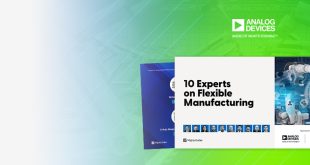The component distribution industry has never before presented such a changing landscape. New business models are emerging and customer dynamics and behaviours are changing. All this is happening against a background of acquisitions serving to consolidate the market to fewer players, and distributors buying companies to support the business or offer fresh opportunities. Kurt Colehower, president Global Sourcing, RS Components tells us more
But whatever the changes in the underlying market place, from suppliers there is just one mantra for distributors – deliver my products to more engineers, follow their project journey, supply them with information, and keep them close.
Historically, the electronic component distribution industry was very straightforward. Broadline distributors supplied volume while high service distributors looked after the smaller volume requirements of engineers setting out on a new product development. The broadliners occasionally eyed the high service distributors push into volume with suspicion, while the high service sector observed forays onto their patch by the broadliners.

Today there are many more factors at play. Customers are becoming more demanding and purchasing behaviours are changing. What keeps me up at night is the fear that our business model becomes irrelevant. Today’s fast pace of change makes things obsolete and irrelevant much faster. To stay relevant requires more than great products, great service and a great customer experience; it requires rapid adaption to the changing landscape and changing times. The traditional paper catalogue is long gone as access to information has become key. Customers want instant access to product, service and supply information that is accurate, thorough and easy to access when making their purchasing decision.
One thing is sure; the agility to conquer the digital world will dictate the winners here. Online trading is ubiquitous, and none of us will tolerate shoddy service. Engineers need distributors who can keep it simple. They want to know the product they require is in stock, they want as much information as they can get on the product, and they want it delivered on time along with all the other components they need in one delivery. They require the ability to place, manage and track orders from any portable device.
I would argue that the high service distributors are better placed in this space as the high service sector was swift in adopting eCommerce, high service distributors placed themselves at the forefront of gathering customer analytics, which can be used to help support customers to make the right choices for their end application, and it can aid suppliers with information about how and where their product is being used and how it is perceived.
RS entered the eCommerce world over 20 years ago and has been developing its digital capabilities and services ever since. The regional digital revenues tell their own story – Europe contributes 70 per cent and Asia Pacific stands at over 50 per cent. In Japan the figure is outstanding at over 90 per cent.
These strengths give high service distributors a clear, competitive edge as consumers are now expecting a B2C type online experience and new eCommerce competitors are entering our market. There is no doubt that these players are setting the consumer expectations for online search, find, order and delivery but are they really a threat for engineering B2B distribution and more specifically electronic component distribution?
At this stage the answer is no. Electronics and engineering distribution demands an expert skill set, and technical support and product expertise remain key. Suppliers are looking for distributors who work as a partner to develop new markets and customers for their products, with our sales force often seen as an extension of their own sales teams. Engineers are looking for a partner that can provide complete solutions to their design, build and MRO needs, and at RS we are building out a suite of services to make our customer lives easier right across the product lifecycle. Finally and perhaps most importantly, industry and product regulations mean distributors must guarantee genuine parts and compliance to specific regulations, along with specific product handling standards for many of our parts. The market place business model makes it hard for the big eCommerce giants to make these guarantees.
At RS we have a very large technical product offering, which provides customers with breadth of range encompassing electronic components, test and measurement, automation and control and tools and consumables products.
We see our broad product range as a major strength as we look towards one of the other big market shifts – the growth of mechatronics. Electronics, computing, mechanical and control systems are converging and, as such, so are the engineering disciplines along with the skills of the engineering workforce. The convergence within design, manufacturing and MRO at a customer level affects the products that are specified in a single order. This provides a wealth of opportunity for RS, which offers over 500,000 industrial and electronics products and an expanding range of value-added services. Currently RS serves a diverse number of businesses that require both industrial and electronics components and want to procure them and utilise the supporting services from one source.
The product offering is being further strengthened as RS develops a revitalised strategic focus on electronics as a core component of its overall growth strategy. We are constantly surveying customers and suppliers with a focus on what they need from high service distributors. Back to basics was the predominant message: carry an inventory that encompasses a breadth and depth of the products that matter most, have high availability of the products that matter most, and offer a reliable and dependable delivery service.
Based on their insights we continue to develop our electronics business to focus on board level electronics. We have added over 120,000 new articles with components sold as received, in manufacturing packaging. We are creating a truly global offering and continue to build and strengthen our services across the low-volume, high-mix (LVHM) product lifecycle, including design and development, LVHM production and support for customers on end-of-life and obsolescence challenges.
To support these goals we have recently made organisational changes to reflect the importance of this strategy. Electronics now reports to me and we have built a new empowered purpose-built organisation with industry-leading resources. We have established Munich as our global and European headquarters for electronics, positioning ourselves closer to our suppliers and large customers.
We will develop our strong foundation in EMEA, build on our presence in Asia Pacific and, in the longer term, increase our exposure in North America and enhance our reputation as a truly global player.
This reinvigorated electronics offer will be supported by a repurposing of DesignSpark, our engineering community, to take advantage of the 700,000 engineers who have joined and give them access to our suppliers’ tools and products, and relevant information.
Recent research amongst the DesignSpark engineering community clearly showed that they joined because they see it as a valuable learning source as well as being part of a community where information can be shared. Powerful software offerings provide an entry point into designing products. They learn about what is new and interesting from suppliers, and look for connections to people they can work with.
As we look into the future, another threat on the horizon is the growing shortage of engineering skills across Europe. Not enough young people are taking up STEM subjects and choosing engineering-based careers with the knock-on impact of this affecting where products are designed and manufactured through the availability of workforce resource. As a business that serves the engineering industry, we have a duty as well as the ability to inspire and influence the next generation of engineers. In the UK alone research shows that for every engineering job a further 1.74 jobs are generated in the British workforce. And in the UK, the decision to leave the EU brings further uncertainty.
We have embraced this responsibility and over the last few years, we have invested in a variety of ways to encourage young people into engineering. We have introduced and implemented a number of initiatives, such as: Titan II (a 35-tonne truck packed to the gunwales with a wide range of technologies which we take into schools), Eagle Labs, university programmes, educational exhibitions, STEM ambassador programmes, Formula Student, Hyperloop, and FIRST LEGO League sponsorships, and of course DesignSpark, our online community and resource centre. Our goal is to support and inspire budding young engineers on their paths to becoming the future stars in the industry.
It is heartening to see the impact that these initiatives have through the excitement of schoolchildren that we engage with. If just one or two think ‘this is the career for me’, it makes such investments worthwhile. Titan II will be taking this message out into Europe in the lead up to electronica and will then make its way to Munich where it will be making a big impact at the exhibition.
All these strengths will come into play as we look into the future of the distribution sector. Consolidation will continue and the industry will become larger and less fragmented. We are already seeing distribution take a greater share of the components total available market (TAM). Value-added services will increase dramatically as a percentage of a distributor’s business. Software, IoT services, Blockchain and AI solutions will come into play as distributors offer innovative solutions beyond hardware; a requirement that will be demanded by customers and suppliers alike.
Amid all of this rapid change, the message is clear: we must adapt to succeed. And a strategy that keeps us relevant will go far in warding off those sleepless nights.
 CIE Components in Electronics
CIE Components in Electronics


